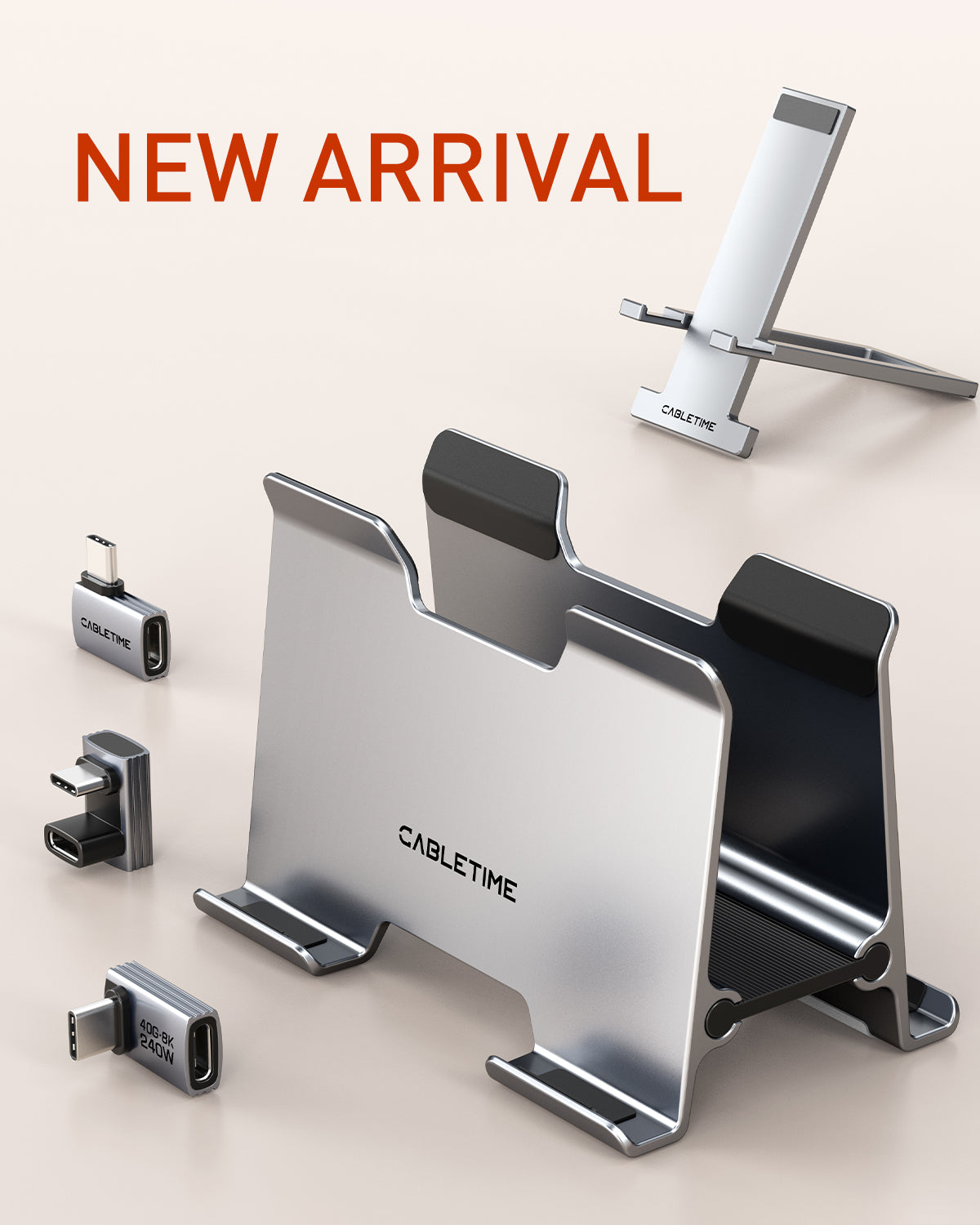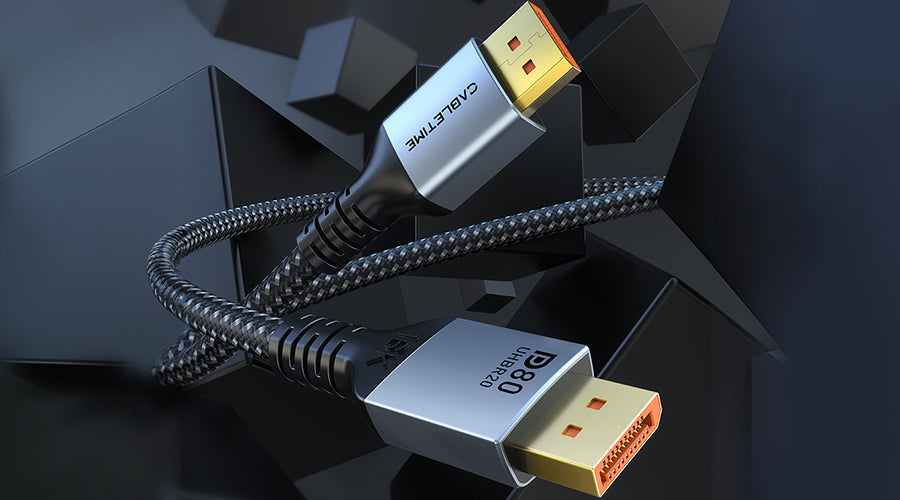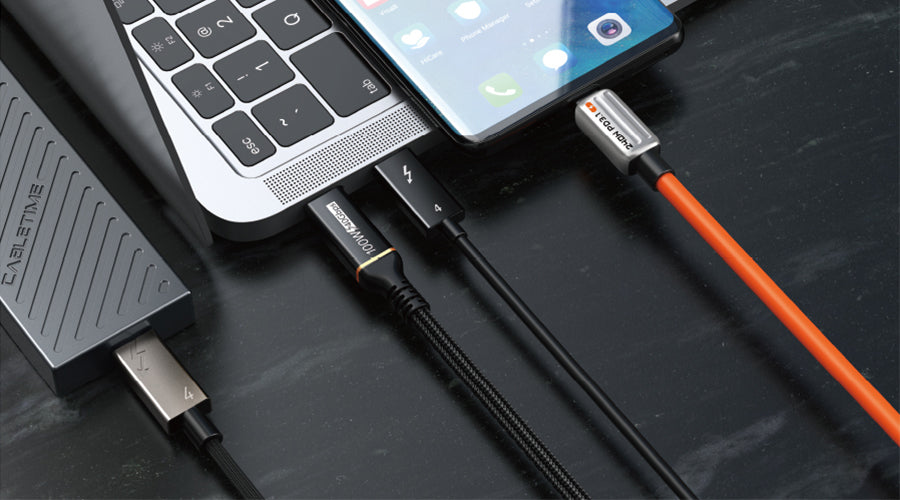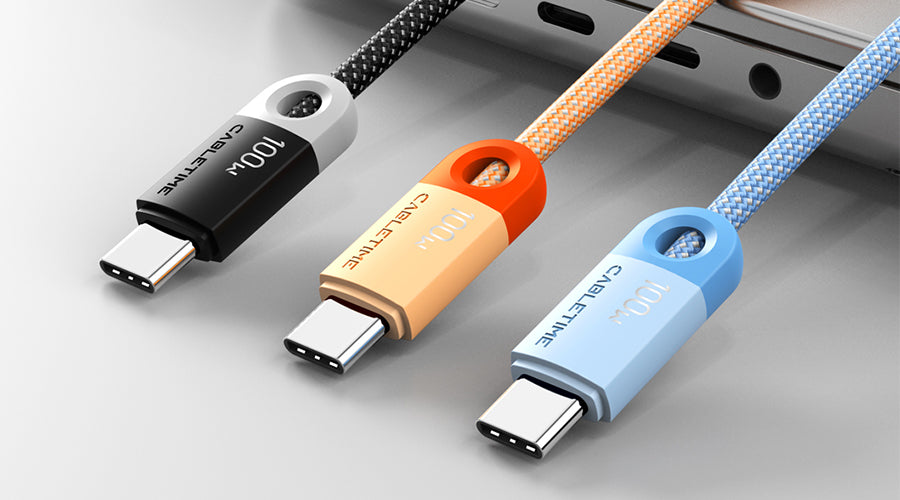مع انتشار الشاشات عالية الدقة بشكل متزايد، أصبحت القدرة على نقل الصوت عالي الجودة مع الفيديو أمرًا بالغ الأهمية. توفر DisplayPort، واجهة الاتصال الرقمية عالية السرعة المستخدمة على نطاق واسع مع الشاشات وأجهزة الكمبيوتر، دعمًا قويًا لنقل الصوت متعدد القنوات بين الأجهزة.
جدول المحتويات
نظرة عامة على دعم DisplayPort Audio
تم تصميم DisplayPort ليس فقط لنقل الفيديو ولكن أيضًا لنقل الصوت الرقمي غير المضغوط. وهذا يسمح لاتصال DisplayPort واحد بالتعامل مع كلتا المهمتين - تقديم صور واضحة للغاية للشاشات مع إرسال صوت متعدد القنوات إلى مكبرات الصوت أو سماعات الرأس.
يتم دعم العديد من تنسيقات الصوت المحيطي الراقية، بما في ذلك:
- دولبي أتموس
- دي تي اس:اكس
- 1 صوت محيطي
وهذا يجعل DisplayPort مناسبًا تمامًا لأجهزة الكمبيوتر المخصصة للألعاب والمسرح المنزلي حيث تكون هناك حاجة إلى صور رائعة وصوت غامر. يمكن للصوت متعدد القنوات أن يعزز التجارب، مما يسمح بتحديد موقع الأصوات بدقة لتعزيز الحدث على الشاشة.
على سبيل المثال، في لعبة إطلاق النار من منظور الشخص الأول، توفر القدرة على سماع الأعداء وهم يزحفون من القنوات الجانبية أو الخلفية ميزة تكتيكية وتزيد من التوتر. عند مشاهدة أفلام الحركة، يجعل الصوت التوجيهي المشاهدين يشعرون وكأنهم داخل تسلسلات متفجرة حيث تنتقل المؤثرات من قناة إلى أخرى.
كيف يتعامل DisplayPort مع الصوت عالي الدقة
يستخدم DisplayPort نظامًا قائمًا على الحزم عالي النطاق الترددي يوفر سعة كبيرة لنقل الصوت غير المضغوط دون التأثير على أداء الفيديو. تتمتع الواجهة بالإنتاجية اللازمة لدعم تنسيقات مثل Dolby TrueHD وDTS-HD Master Audio التي تستخدم الترميز الخالي من الفقدان لتحقيق أقصى قدر من الدقة.
تُستخدم قنوات مساعدة مخصصة في DisplayPort لنقل الصوت متعدد القنوات I2S. يتم تضمين إشارات الساعة مباشرة في تدفقات البيانات للحفاظ على مزامنة الفيديو والصوت بشكل مثالي. يتيح هذا تشغيلًا خاليًا من الخلل حتى مع تكوينات الصوت المحيطي المعقدة.

للحصول على أفضل تجربة صوتية، يجب أن تستخدم وصلات DisplayPort كبلات وتوصيلات ذات حماية ثابتة لمنع التداخل. يمكن أن يؤدي التلعثم الجزئي أو انقطاع الإشارة المؤقت إلى حدوث أصوات فرقعة ونقرات في تشغيل الصوت إذا كانت التوصيلات فضفاضة أو كانت الكابلات معيبة. يعد استخدام أسلاك DisplayPort عالية الجودة أمرًا أساسيًا.
شروط نقل الصوت عبر DisplayPort

يتطلب نقل الصوت متعدد القنوات عالي الدقة بعض المتطلبات الأساسية عند استخدام DisplayPort:
دعم الأجهزة
يجب أن يحتوي كل من جهاز مصدر DisplayPort وشاشة الاستقبال/مكبرات الصوت على أجهزة تدعم الصوت متعدد القنوات عبر DisplayPort. تتضمن العديد من أجهزة DisplayPort الحديثة هذه الإمكانية، ولكن الوظائف قد تختلف. تحقق دائمًا من المواصفات للتأكد من أن المكونات تتعامل مع الصوت متعدد القنوات غير المضغوط I2S/PCM.
على سبيل المثال، CableTime's كابلات DisplayPort يذكر صراحة دعم الصوت ذي الثماني قنوات، مما يضمن قدرتهم على نقل الصوت المحيطي المعقد بين أجهزة الكمبيوتر ووحدات معالجة الرسومات والشاشات.
مطلوب إصدار DisplayPort
تم تحديث معيار واجهة DisplayPort بمرور الوقت بميزات جديدة ومستويات نطاق ترددي:
| إصدار | الحد الأقصى للنطاق الترددي | الصوت متعدد القنوات |
| منفذ العرض 1.1 | 8.64 جيجابت في الثانية | لا |
| منفذ العرض 1.2 | 17.28 جيجابت في الثانية | نعم |
| منفذ العرض 1.4 | 32.4 جيجابت في الثانية | نعم |
| ديسبلابورت 2.1 | 80 جيجابايت في الثانية | نعم |

كما يوضح الجدول، توفر إصدارات DisplayPort 1.2 والإصدارات الأحدث أداءً كافيًا للتعامل مع إشارات الفيديو عالية الدقة والصوت متعدد القنوات في نفس الوقت. تلبي معظم أجهزة DisplayPort الحديثة هذه المواصفات، ولكن تحقق من الموديلات مرة أخرى للتأكد من التوافق.
مرة أخرى، يساعد استخدام كابل DisplayPort عالي الجودة والمعتمد مثل تلك التي تقدمها CableTime في ضمان دعم أحدث مواصفات DisplayPort لنقل الصوت والفيديو دون أي عيوب. يمكن أن تؤدي الكابلات الرديئة إلى إبطاء الإنتاجية المحتملة.
تتضمن العديد من وحدات معالجة الرسوميات والشاشات المتطورة الآن منافذ DisplayPort 1.4. وفي حين أن الإصدار 1.4 لا يوفر حاليًا سوى القليل من الفوائد الإضافية لدقة العرض، فإنه يوفر مساحة أكبر لعرض النطاق الترددي لاستيعاب برامج ترميز الصوت والبيانات الوصفية المتقدمة في المستقبل.
كابلات DisplayPort 2.1 متوافقة مع الإصدارات الأقدم من DisplayPort، لذا فإن شراء 1.تساعد الكابلات السلكية الأربعة في إعداد البنية التحتية للمستقبل لتنسيقات الصوت المستقبلية.

إعداد الصوت عبر منفذ DisplayPort واستكشاف الأخطاء وإصلاحها
يعد تكوين إعدادات نظام التشغيل والتطبيق بشكل صحيح أمرًا بالغ الأهمية لتوجيه الصوت متعدد القنوات عبر DisplayPort بشكل صحيح. فيما يلي تفاصيل حول تمكين الصوت عبر DisplayPort واختباره في نظامي التشغيل Windows وmacOS.
تكوين الصوت عبر منفذ DisplayPort في نظام Windows
- افتح إعدادات الصوت
- تحت الإخراج، حدد جهاز DisplayPort
- اختبار الصوت متعدد القنوات باستخدام أيقونات تكوين مكبر الصوت
إذا كان Windows يقوم بإخراج الصوت عبر اتصال آخر بدلاً من DisplayPort، فتحقق مما يلي:
- تبديل جهاز DisaplyPort وإيقاف تشغيله كإخراج افتراضي
- تحديث برامج تشغيل الصوت من الشركة المصنعة لوحدة معالجة الرسومات/الجهاز
- استخدم إعدادات صوت الجهاز الأصلية بدلاً من الصوت المكاني
حاول أيضًا ضبط معدل أخذ العينات وعمق البت وخيارات التنسيق لتتناسب مع قدرات المعدات على طول مسار الصوت. قد يؤدي عدم تطابق الإعدادات بين المكونات إلى منع تشغيل الصوت متعدد القنوات بشكل صحيح.
إعداد الصوت DisplayPort لنظام macOS
- انتقل إلى قائمة Apple > تفضيلات النظام
- انقر على أيقونة الصوت
- حدد جهاز DisplayPort ضمن علامة التبويب "الإخراج"
- انقر فوق زر تكوين مكبرات الصوت
- اختبار تخطيطات مكبرات الصوت متعددة القنوات المختلفة
على نظام التشغيل macOS، إذا كانت هناك مشكلات في الصوت عبر DisplayPort، فحاول:
- تبديل معدلات أخذ العينات المختلفة في إعدادات MIDI الصوتية
- إعادة توصيل كابل DisplayPort
- استخدام منفذ DisplayPort مختلف على وحدة معالجة الرسومات أو الشاشة
يتضمن نظام macOS أدوات قوية لضبط معدلات البت وتخطيطات القنوات وإعدادات الساعة لتثبيت خطوط أنابيب الوسائط DisplayPort. حاول استخدام معدلات أخذ عينات أو أعماق أعلى إذا ظهرت مشكلات في الجودة.
في تكوينات المسرح المنزلي، قد توفر أجهزة استقبال AV خيارات تكوين الصوت بدلاً من نظام التشغيل. راجع وثائق جهاز الاستقبال لمطابقة الشاشات وأجهزة الوسائط مع مكبرات الصوت المادية بشكل صحيح.
DisplayPort مقابل HDMI: مقارنة بين ميزات الصوت

HDMI هي الواجهة الأكثر شهرة للاتصال الصوتي/الفيديوي. كيف تقارنها بـ DispalyPort فيما يتعلق بالمهام الصوتية؟
دعم تنسيق الصوت
يمكن لكل من HDMI وDisplayPort التعامل مع التنسيقات المضغوطة الشائعة مثل Dolby Digital القياسي وصوت DTS المحيطي. ومع ذلك، فإن النطاق الترددي الأعلى لـ DisplayPort يتيح نقل خيارات متعددة القنوات أكثر تقدمًا، بما في ذلك:
- دولبي أتموس
- دي تي اس:اكس
- دولبي ترو اتش دي
- نظام الصوت الرئيسي DTS-HD
تُستخدم تقنيات الصوت الغامرة هذه بشكل متكرر في تكوينات المسرح المنزلي. ويتميز منفذ DisplayPort بقدرته على نقلها سليمة لفك تشفيرها بواسطة أجهزة استقبال AV.
لقد زاد HDMI 2.1 مؤخرًا من الإنتاجية المتاحة لمنافسة DisplayPort 1.4، لذا فهو الآن يدعم أيضًا التنسيقات المحسنة مثل Dolby Atmos. يدعم كل من HDMI وDisplayPort الصوت غير المضغوط، ولكن HDMI يرتبط عادةً بالتنسيقات المضغوطة في الاستخدام في العالم الحقيقي، بينما يركز DisplayPort بشكل أكبر على تقديم صوت عالي الجودة بدون فقدان.
جودة الصوت
يدعم HDMI الصوت المضغوط لنقل فعال، على الرغم من أن تدهور الإشارة قد يؤثر على الجودة. يستخدم DisplayPort تنسيقات الصوت الخالية من الفقد للحفاظ على دقة الصوت عند تشغيلها على مكبرات الصوت وسماعات الرأس.
يتطلب الصوت غير المضغوط نطاقًا تردديًا أكبر بكثير، وهذا هو السبب في أن HDMI لا يزال يفضل بعض الضغط حتى في مستويات المواصفات الأعلى.تستوعب واجهة DisplayPort القائمة على الحزم التدفقات غير المضغوطة بشكل أسهل.
حماية النسخ
يدعم كل من HDMI وDisplayPort تقنية HDCP (حماية المحتوى الرقمي عالي النطاق الترددي) لتشغيل الوسائط المحمية، ولكن يتم استخدام HDMI في أغلب الأحيان لحماية المحتوى التجاري.
تكمن المقايضة هنا في أن نظام DRM القوي الذي يتمتع به HDMI يجعله مفضلاً لدى استوديوهات الأفلام للتوزيع، في حين يفضل DisplayPort المرونة والجودة على حماية الحقوق.
قابلية التطبيق
تتمتع كلتا الواجهتين بتوافق واسع النطاق مع الشاشات وأجهزة التلفاز وبطاقات الرسوميات وأجهزة الوسائط. إن قدرات DisplayPort على تشغيل شاشات عالية الدقة بمعدلات تحديث أسرع تجعلها أكثر جاذبية للألعاب واستخدام الكمبيوتر الشخصي. تتمتع HDMI باعتماد أوسع في المسرح المنزلي لأنها تربط بسهولة بين مكونات AV.
يقوم المصنعون دائمًا تقريبًا بتضمين اتصال HDMI وDisplayPort في وحدات معالجة الرسومات والشاشات وأجهزة الاستقبال المتميزة لضمان التوافق. يمكن أن يؤدي استخدام محولات المحول عند الضرورة إلى سد فجوات الاتصال بين أجهزة HDMI وDisplayPort.
في النهاية، يتمتع كلا المعيارين بمزايا. ويعتمد اختيار DisplayPort أو HDMI على أولويات حالات الاستخدام التي تتضمن دعم العرض وجودة الصوت وحماية المحتوى وتكامل النظام البيئي للأجهزة.

الاتجاهات المستقبلية في تقنية DisplayPort Audio
تستمر تقنية DisplayPort في التطور بسرعة لمواكبة أحدث دقة عرض ومعدلات تحديث وتنسيقات الصوت من الجيل التالي. ما الذي يحمله المستقبل لصوت أكثر تقدمًا عبر اتصالات DisplayPort؟
دعم بيانات HDR الديناميكية
تتطلب مقاطع الفيديو ذات النطاق الديناميكي العالي الناشئة بيانات تعريفية مصاحبة لـ HDR حتى تتمكن الشاشات من عرض الألوان الزاهية والتباين الغني بشكل صحيح. يمكن لنظام DisplayPort القائم على الحزم أن يدمج بيانات تعريفية صوتية محسنة في المستقبل بحيث يتم تحسين الإشارات الصوتية استنادًا إلى معلومات فيديو HDR من DisplayPort.
على سبيل المثال، يمكن للبيانات الوصفية توجيه الصوت متعدد القنوات لتكثيف تأثيرات معينة أثناء عرض HDR الزاهية، أو تغيير حجم القنوات المحيطة بشكل دقيق لتتناسب مع عناصر الصورة الساطعة والداكنة.
التكامل الصوتي القائم على الكائنات
تستخدم منصات الصوت المحيطي القائمة على الكائنات عناصر صوتية منفصلة يمكن تحديد موقعها ونقلها في مساحة ثلاثية الأبعاد، مما يتيح تجارب أكثر غامرة. تتمتع DisplayPort بالأساس اللازم للتقدم نحو التعامل مع هذه التنسيقات المعقدة القائمة على الكائنات.
مع تتبع كل كائن يولد صوتًا كنقط بيانات مميزة، يفتح الصوت القائم على الكائن مستويات جديدة من الواقعية. وعلى الرغم من أن HDMI هو الخيار الرئيسي حاليًا لدعم تنسيقات الصوت القائمة على الكائن مثل Dolby Atmos وDTS، فإن واجهة DisplayPort المرنة لديها القدرة على دعم تقنيات مماثلة مع استمرارها في التطور.
تحسينات النطاق الترددي والضغط
من المتوقع أن يزيد DisplayPort 2.0 من عرض النطاق الترددي المتاح إلى 77.4 جيجابت في الثانية. ومع الجمع بين تقنيات خفض معدل البت المحسّنة، فإن الجيل التالي من DisplayPort لديه القدرة على توفير إصدارات خالية من الفقدان من الصوت المكاني الأكثر تقدمًا.
سيوفر DisplayPort 2.0 معدل نقل بيانات ثابت وموثوق به يصل إلى دقة فيديو تصل إلى 16 كيلو بايت إلى جانب متطلبات صوتية متزايدة. كما أن النطاق الترددي الأكبر يمكّن DisplayPort من نقل تنسيقات صوتية عالية الجودة وعدد كبير من القنوات.
ومع استمرار نمو محتوى الوسائط والألعاب، نتوقع أن تنمو مواصفات DisplayPort بالتوازي مع ذلك - مما يمنح المستخدمين إمكانية الوصول إلى مجموعات متطورة من الصور عالية الدقة والمناظر الصوتية متعددة الأبعاد.
إعادة تصميم الموصلات
تهدف إصدارات DisplayPort المحدثة إلى توفير مساحات أصغر مع الاستمرار في توفير اتصال قوي.تعمل منافذ DisplayPort الأقل إزعاجًا على التخفيف من مشكلات ازدحام الواجهة.
يجمع تكامل Thunderbolt بين منافذ متعددة مع الحفاظ على قوة إشارات الصوت والفيديو. ومع ذلك، لا تزال منافذ DisplayPort وHDMI مهمة، وخاصة للأشياء مثل المسارح المنزلية والإلكترونيات الاستهلاكية.
خاتمة
نعم، يتضمن DisplayPort دعمًا قويًا ومخصصًا لنقل الصوت الرقمي متعدد القنوات. تتيح التنسيقات غير المضغوطة نقل الصوت المحيطي الغامر بسلاسة بين بطاقات الفيديو الحديثة والشاشات ومعدات الصوت باستخدام كابلات DisplayPort القياسية.
إن فهم إمكانيات DisplayPort يمكن أن يساعد في إنشاء إعدادات سطح المكتب والألعاب والمسرح المنزلي التي تجمع بين الدقة البصرية المذهلة وإعادة إنتاج الصوت عالي الدقة بشكل مثير للإعجاب.
تبدو خريطة طريق DisplayPort مشرقة من حيث تشغيل الصور بمعدلات إطارات مذهلة والمناظر الصوتية بدقة مكانية فائقة. استفد إلى أقصى حد من الشاشات وبطاقات الرسومات المزودة بإمكانية الاتصال عبر DisplayPort للاستمتاع بعروض صوتية/فيديوية مذهلة اليوم مع الاستعداد أيضًا للتطورات المستقبلية.
5 أسئلة ذات صلة قد يسألها القراء
هل يمكنني استخدام DisplayPort للصوت والفيديو في نفس الوقت؟
نعم، ينقل DisplayPort الإشارتين في نفس الوقت عبر كابل واحد.
هل يدعم DisplayPort تنسيقات الصوت المحيطي؟
إنه يتعامل مع المعايير الشائعة مثل Dolby Digital وDTS. كما يدعم DisplayPort 1.2+ التنسيقات المتقدمة مثل Dolby Atmos.
كيف أقوم بتحويل إخراج الصوت إلى DisplayPort على جهاز الكمبيوتر الخاص بي؟
يحتوي نظاما التشغيل Windows وmacOS على إعدادات صوت لتحديد إخراج الصوت عبر DisplayPort.
ماذا يجب أن أفعل إذا لم يكن DisplayPort ينقل الصوت؟
تحقق من توصيلات الكابلات، وإعدادات الصوت في نظام التشغيل، وقم بتحديث برامج تشغيل الأجهزة، وجرب منافذ مختلفة.
هل هناك فرق في جودة الصوت بين HDMI وDisplayPort؟
توفر تقنية DisplayPort جودة غير مضغوطة بدون فقدان للبيانات بينما يتم ضغط الصوت عبر HDMI في أغلب الأحيان.






اترك تعليقًا
This site is protected by hCaptcha and the hCaptcha Privacy Policy and Terms of Service apply.